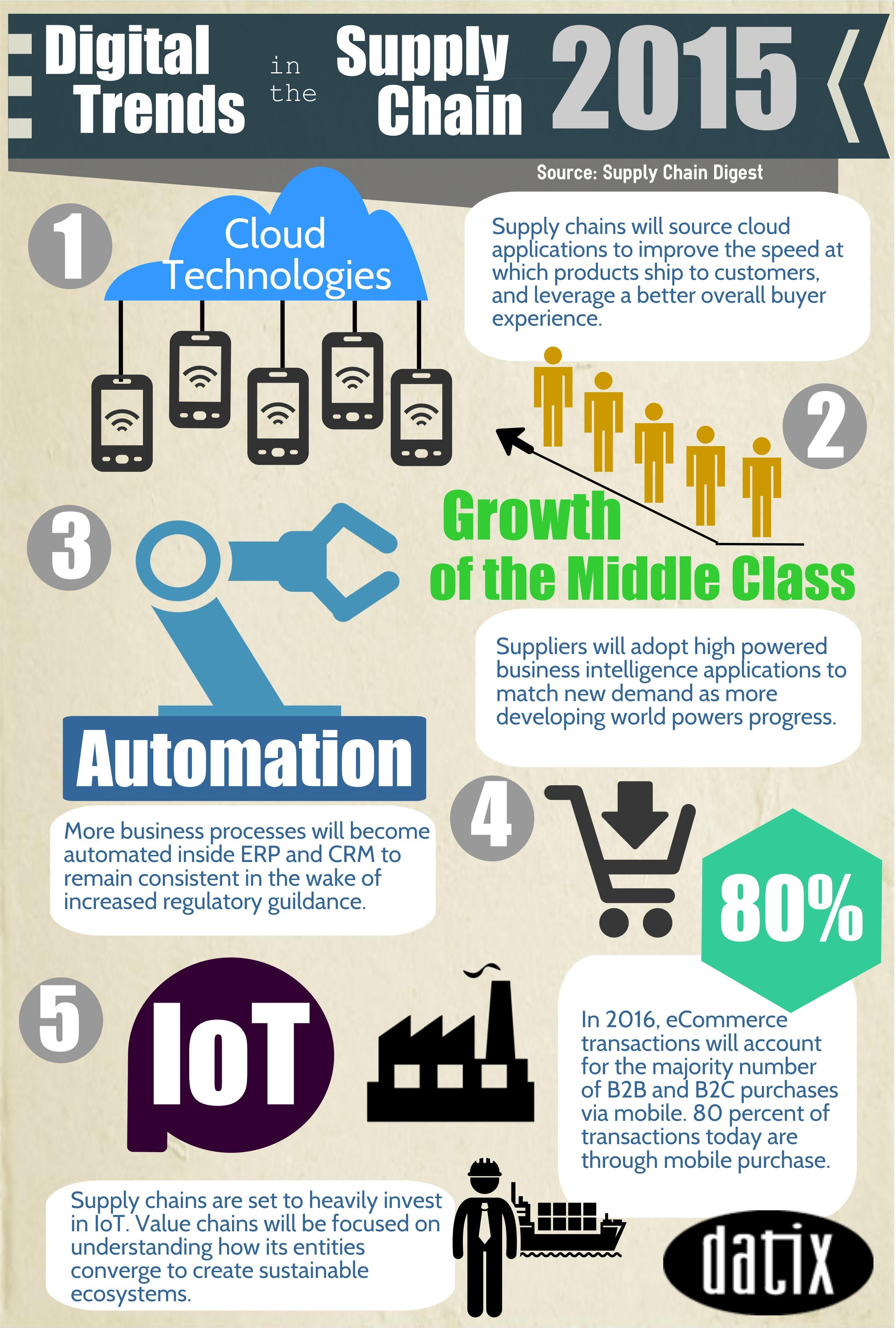
Earlier this year we honed in some of the biggest challenges facing midsize food supply chain technology this year; such as regulatory compliance and TQM retooling. We aimed to identify how strategic innovations in ERP and CRM systems could potentially safeguard these entities from running into costly complications in the near future. Now we’re turning our attention to other areas of supply chain technology.
On the IT agenda this year, there is likely to be heavy investing in things like cloud-computing, APIs for security, agile BI applications, and IoT to optimize economies of scale as new world markets emerge and develop. Some of these things are apparent, others are dovetailing off of other recent innovations.
New markets have perpetuated a rise in product demand; this is primarily driven by the adoption of mobile Ecommerce. This mobile availability has provided new access to markets that simply din’t exist before. Surges in demand also foster a need for an expedited shipping processes—a real challenge for some midsize supply chains— this year and involve an entire revision of digital ecosystems. A primary deliverable in this process is the realignment of business processes throughout the supply chain to ensure they are more collaborative, transparent, and consumer-focused.
The Top Digital TrendsIn Supply Chain Technology
-
Cloud Technologies
More and more supply chains are moving from on premise legacy systems to cloud-based platforms. Cloud technology computes large amounts of data in a matter of only a few seconds; whereas on premise systems working off of large networks and servers potentially holdup processes. Supply chains are becoming wholly focused on driving revenue from faster selling processes and procurement activities. Ultimately, supply chains aim to fill gaps in areas where lead time is hindered do to cumbersome processes or sluggish software.
-
Growth of the Middle Class
Increased connectivity between people, trade, and capital has drastically transformed the state of international business. Over the last 30 years, second and third world countries have come to be global super powers abundant with natural resources and materials. A reduced number of barriers to entry and democratic openness has caused a large number of midsized suppliers to flourish across areas of Cuba, Brazil, and India. As a result, the of growth employment has pushed many povern-stricken groups into the middle class and thus created a rise in consumer product demand. Many supply chains are adopting robust business intelligence applications to determine which global segments display the highest potential for profit.
-
Automation
Supply chains are beginning to see the vast benefit of automated system processes. New regulatory guidelines – both in the U.S. and across the globe – demand supply chains revamp infrastructure to appear more transparent for auditing purposes. Automation ensures procurement, storage, production, and distribution activities remain consistent and are configured with an end user in mind. The idea is to protect buyers from receiving non-conforming goods and services. Likewise, automation allows enterprises to take a hands off approach to production and eliminate manual, cumbersome tasks that contribute to high direct costs and poor practices. Automation is the future of industrial supply chains; as it allows firms to increase the level of output with only a minimal amount of input.
-
Mobilization
E-commerce is widely popular with both B2B and B2C mobile users. Today, there are over 77 billion mobile users; including the majority with significant buying power. In 2016, e-commerce transactions will account for 80% of both B2B and B2C purchases via mobile phone. It would be wise for supply chains to investment in big data analytic applications to build long term demand estimates as this number increases.
-
IoT
The term IoT was introduced into IT acumen to express the growing number of sensor-embedded devices passing large, quantifiable amounts of data from consumers to supply chain members. This year, supply chains are heavily investing in IoT to optimize consumer insight data. This information will wholly determine who customers are and where they come from at the most granular level. It also allows enterprises to take an internal inventory of their processes to eliminate waste and cut costs that may pass onto a buyer.
We can expect supply chains to adopt IoT innovations which should in turn give rise to things like RFID tags. RFID tags are an electronic tag which automatically identifies and tracks other RFID tags attached to objects. In warehousing, RFID tags prompt smarter inventory management, faster movement of materials, and increased visibility of all objects to prevent cross-contamination of goods. Investing in IoT may also benefit distribution and freight. Improved fleet management may include faster traceability of raw materials and finished goods, accurate reporting for compliance, and better prediction of asset failure and preventive maintenance scheduling.
If your business is interested in integrating ERP or CRM, or is considering implementing a new system, speaking with a Datix expert could prove extremely help. Feel free to reach out today.

